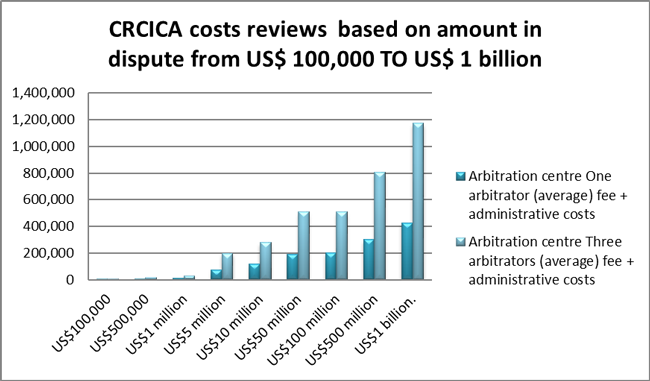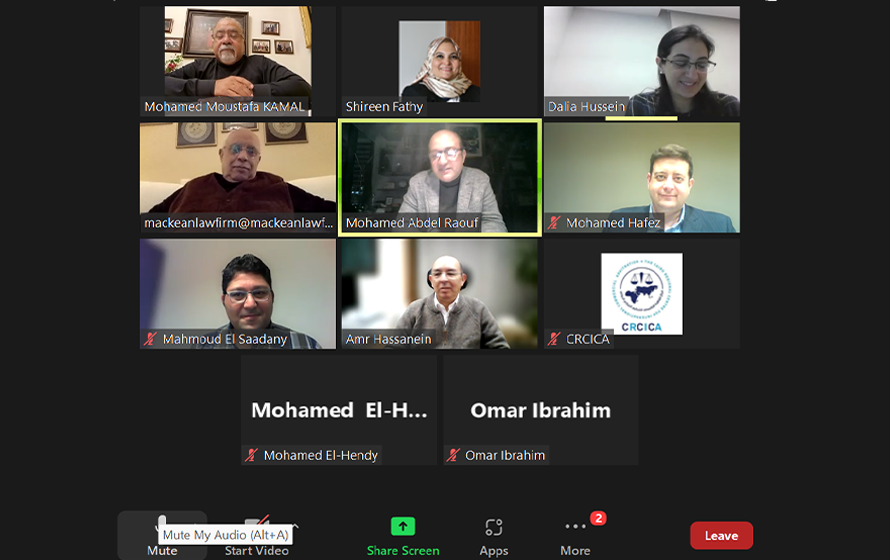
In September 2017, GAR published “Arbitration costs compared”, a survey comparing the costs of 18 major arbitral institutions prepared by a team led by Louis Flannery, Head of International arbitration at Stephenson Harwood. The survey has built on previous comparisons published in GAR in 2010 and 2013.
In this survey, CRCICA is the only representative of Africa and one of only two arbitration centres representing the MENA Region. The list of featured centres includes the International Court of Arbitration of the International Chamber of Commerce (ICC), the Arbitration Institute of the Stockholm Chamber of Commerce (SCC) and the Kuala Lumpur Regional Centre for Arbitration (KLRCA).
The 2017 version of the study has continued comparing the costs of arbitration when nine different amounts are in dispute ranging from US$100,000 to US$1 billion, noting that the said costs include the arbitrators’ fees, administrative costs and registration fees. The costs have been calculated based on a tribunal consisting of either one or three arbitrators.
Where does CRCICA Fit up the Scale?
Notably, throughout the study, the scaling of CRCICA costs gradually increase, based on the amount in dispute (chart II) and adopts a somehow erratic shape, featuring a peak at the 10-million edge, when compared to the other 17 centres (chart I). It is interestingly obvious that both charting criteria show almost flat graphs until the amount of US$ 1 million where CRCICA is the cheapest in case of one arbitrator and among the top three cheapest in case of three arbitrators. For cases worth US$ 500,000, CRCICA is the cheapest institution for cases worth US$500,000, irrespective of the size of the tribunal.
Remarkably, CRCICA, which was consistently one of the cheaper institutions for disputes worth US$1 million and less, sits at the middle of the table for three-member tribunals for disputes worth US$ 5 millions. For disputes worth 10 millions dollars, CRCICA costs continue increasing in comparison to its position in disputes of lesser amounts.
For the 100-million disputes, CRCICA nearly occupies the middle ground for three-member tribunals. The curve then retreats featuring CRCICA among the most affordable for sole arbitrator disputes worth US$500 million.
Extra-textual Commentary:
CRCICA Modus Operandi and the transparency of administering costs determination
Researchers noted that they have not taken into account circumstantial practices. CRCICA has developed a number of institutional tools to minimize the effect of likely circumstantial practices that might affect the soundness and transparency of the arbitral process. Beside a set of rules focusing on costs and regulating an array of relevant circumstances likely to occur during the arbitral process, the Centre issued Practice Notes reflecting and governing its institutional policies regarding eight important decisions, four of which are costs-related including two issues of costs determination. Whilst the aforementioned study based its findings on the average scale of fees under table (3), it is worth noting that according to Article 5 of CRCICA Practice Notes, where the sum in dispute exceeds three million US $, the Centre has the discretion to define the fees according to the minimum scale set out in Table (3) annexed to the Rules, unless the complexity of the dispute, the high sum in dispute or the seniority of arbitrators requires the application of a higher value up to the maximum scale mentioned in the said table. It is not all about regulatory texts, an important factor of CRCICA’s sustainable institutionalism is the strategic role of its Advisory Committee. The AC provides advices and decide on important applications of the CRCICA Rules including the appointment and challenge of arbitrators as well as the determination of fees in some cases:
Indeed, in exceptional circumstances, the Centre may, upon the approval of the Advisory Committee, determine the fees of the arbitral tribunal at a figure higher or lower than that which would result from the application of Table (2) or the scales set out in Table (3) annexed to these Rules, provided that such determination does not exceed 25% (Article 45 (12).

How would this study help ?
The comparison is meant to be a tool of use for arbitration practitioners and their clients as well as to arbitrators. It may also be of assistance to new institutions considering an ad valorem basis for the calculation of their costs and to existing institutions that might be considering revising their fees. CRCICA will build on the outcome of this survey in studying the effect of its revised scheduling of costs on its future practices.




